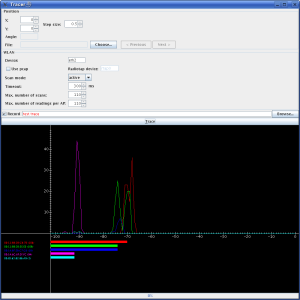Loctrace contains only one application: Tracer. Tracer is used to collect the data required to create fingerprint databases. To achieve this goal, Tracer is build on top of Loclib and directly retrieves sensor-specific data (e.g., the signal strength of access points within communication range in an 802.11-based wireless network). It contains a graphical user interface (GUI) to make the configuration process easy to handle (e.g., select a scanning mode and the scanning device). Various parameters such as the number of scans or the delay between two consecutive scans are also configurable through the GUI. If the trace process is started, a histogram pops up in the bottom part of Tracer showing the access points within communication range and their corresponding signal strength distributions. A screenshot of the Tracer GUI is depicted in the following figure:
 |
| Screenshot of Tracer |
The data collected from Loclib is stored in a human-readable trace file and contains lines that adhere to the following format:
- t: timestamp in milliseconds since midnight, January 1, 1970 UTC
- pos: the physical coordinate of the scanning network device
- id: MAC address of the network device used for scanning
- degree: direction of the user carrying the scanning device in degrees (only set if a digital compass is available)
- MAC: MAC address of a responding peer (e.g. an access point or a device in adhoc mode) with the corresponding values for signal strength in dBm, the channel frequency, its mode (access point = 3, device in adhoc mode = 1) and noise level in dBm.
Trace files generated by Tracer are a major building block for our overall research process. These files can be used by Loceva to evaluate and emulate different positioning algorithms and scenarios. Furthermore, the traces can be displayed for visual inspection by tools of the Locana package. Finally, these traces can be used as an offline fingerprint database during normal operation of an 802.11-based positioning system.